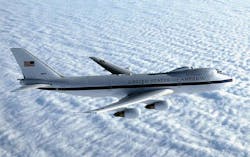Officials of the Air Force Life Cycle Manager Center at Tinker Air Force Base, Okla., have awarded a $9.8 million contract to the Boeing Defense, Space & Security segment in Oklahoma City, Okla., to develop an E-4B low frequency transmit system.
The Air Force E-4B Advanced Airborne Command Post represents a fleet of four modified Boeing 747-200 jumbo jets that serve as survivable mobile command posts for the president of the United States, the U.S. secretary of defense, and other U.S. national command authorities.
Related: Northrop Grumman to build SATCOM capability for E-6B strategic airborne command post
When airborne, the E-4B operates as a national airborne operations center to enable national command authorities to maintain control over nuclear and conventional military forces if more conventional means of command and control have been destroyed or disabled from war damage or other disasters.
The aircraft is a survivable, command, control, and communications center to direct U.S. forces, execute emergency war orders, and coordinate civil authorities' activities, including national contingency plans.
The E-4B aircraft's low frequency transmit system sends instructions to submerged ballistic missile submarines. The LFTS can transmit signals as strong as 100 kilowatts over low frequencies of 28 to 60 KHz -- lower frequencies than commercial AM broadcast radio -- to send encrypted text messages to submerged submarines.
The LFTS enables the aircraft to maintain control of the ballistic missile submarine component of the U.S. so-called nuclear triad that also includes strategic bomber aircraft carrying atomic bombs, as well as land-based nuclear-tipped intercontinental ballistic missiles.
The E-4B also maintains contact with other nuclear forces via advanced extremely high frequency (AEHF) satellite communications and other secure communications systems.
The LFTS program will replace the current very low frequency/low frequency (VLF/LF) transmit system that is on the E-4B. The current system has been on the E-4B for more than 35 years and is past its useful life, Air Force officials say.
Related: Nuclear ballistic missile command and control
The transmit system consists of three primary equipment groups: a receiver/transmitter group, a power amplifier-coupler (PA-C) group, and a trailing wire antenna (TWA) group.
On this contract Boeing will do the work in Oklahoma City, Okla., and should be finished by April 2015. For more information contact Boeing Defense, Space & Security online at www.boeing.com/boeing/bds, or the Air Force Life Cycle Manager Center at www.wpafb.af.mil/aflcmc.



